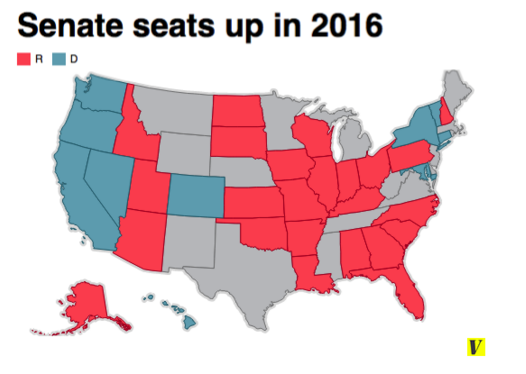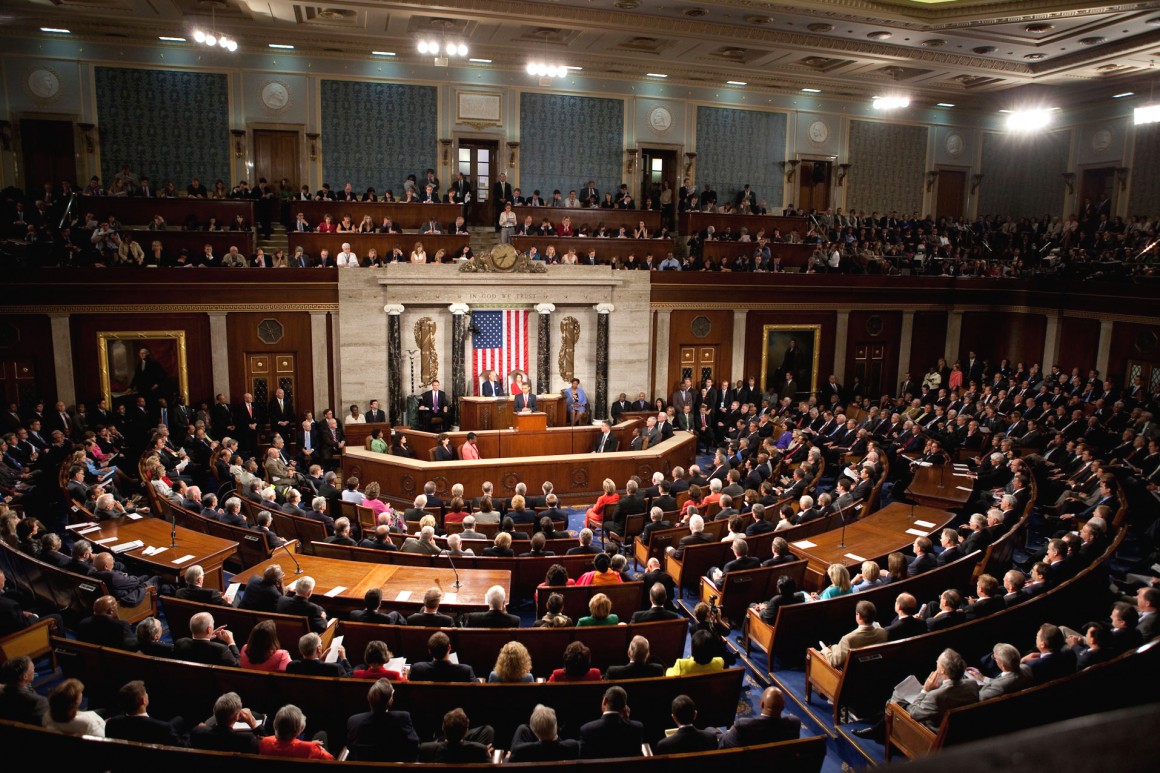Given all that has happened so far this election cycle, it’s easy to understand how American voters have been focused solely on the presidential contest. Whoever ends up occupying the White House next year will wield tremendous power, but now that the primaries have begun and things are starting to shake out, it’s time to take a look at everything else happening further down the ballot.
First, the bad news…the House will probably remain stuck in its ways regardless of how voters feel
Despite its single-digit approval rating, the makeup of the House of Representatives is largely already decided thanks to electoral mapping. The geography of Congressional districts is determined after each census by the state Legislatures, meaning that they tend to favor whichever party holds power in the state. For this reason, reelection rates in the House have remained over 80 percent for the past 50 years. Since the last census in 2010, Republican have held an overall structural advantage.
Over the past several years there has been an effort by some states to end the process of partisan gerrymandering through legislative action, but even with changes to the law the current congressional districts will remain the same until after the next census in 2020. For the time being, the majority of Representatives will be safe in their single-party dominated seats as long as they can stave off any primary challengers.
As it currently stands Republicans hold 247 seats to the Democrats’ 188, meaning that even if voters tend to lean left (which often happens in presidential election years) the GOP will likely maintain a sizeable majority in the House.
The Senate, on the other hand, will be hotly contested
A third of the Senate is up for re-election every six years, which means that we can learn a lot about this year’s election by looking six years into the past. 2010 was a blockbuster year for the GOP in which the rise of the Tea Party handed John Boehner the Speaker’s gavel and flipped 6 Senate seats to the Republicans. Now many of those Senators are up for re-election in a very different political climate.
Compare this year’s election to the one just two years ago, when the GOP regained control of the Senate. In 2014 there were 21 Democrats up for reelection and only 15 Republicans. This year the electoral math has flipped, with Democrats only having to defend 10 seats to the GOP’s 24. The Democratss need to pick up just five seats to retake control of the Senate and cut short Mitch McConnell’s reign as Majority Leader.

Here are some of the key races to pay attention to in the coming months:
Iowa – A new window of opportunity for the Democrats
Two weeks ago nobody was paying much attention to the Iowa Senate race, assuming that Republican Chuck Grassley would easily win reelection to a seventh term. However, the death of Justice Antonin Scalia has changed the state of play. Grassley serves as the Chair of the influential Judiciary Committee and is therefore the person responsible for presiding over the confirmation hearings of Merrick Garland—President Obama’s nomination for the Supreme Court. The Senator has sided with Mitch McConnell in the decision to not hold hearings on any nominee before the election – a stance which is beginning to spark antipathy among the voters. This intransigence has made Grassley a target for Democrats, who now see an opening for a seat that was once considered safe for the GOP. They have also found a strong challenger in former Democratic Lieutenant Governor Patty Judge. Of course, Democrats still face an uphill battle – don’t forget this is the state that elected Joni Ernst to the Senate in 2014. However the GOP establishment must now devote resources to a race that they thought they had in the bag.
Florida – A crowded field of contenders are vying for Rubio’s old job
Marco Rubio’s decision to forego his Senate reelection bid in order to make a failed bid for the Presidency has created another open seat that Democrats are hoping to pick up. This is still a crowded field, with seven Republicans competing in the primary. On the Democratic side former U.S. Representative Patrick Murphy has picked up the backing of the party establishment, including endorsements from President Obama and Vice President Biden, in his primary fight against the long-time liberal firebrand Congressman Alay Grayson. Florida has voted for the Democratic Presidential Candidate in the last two election cycles, and if Murphy can survive the primary fight he’ll have a good shot at flipping the seat.
Ohio – Democrats may have an advantage
The ultimate swing state, Ohio may once again sway left or right based on what is happening at the top of the ticket. Republican Senator Rob Portman can into office in the Tea Party sweep of 2010, but just two years later the state elected a Democrat to the other Senate seat when Obama was running for reelection. Though Portman has so far outpaced his Democratic opponent Governor Ted Strickland in fundraising, the fact that it is a presidential election year will put him at a disadvantage. This race will also reflect the extent to which Democratic support from rural voters has faded in recent years.
Illinois – Most likely to flip from R to D
Illinois voted to send Republican Mark Kirk to the Senate in 2010, but thanks to electoral math he is now the most likely incumbent to lose his seat. The state has not voted for the GOP Presidential candidate since 1988, and in 2012 native son Barack Obama won it by 17 points. Democrats also have a strong candidate in Representative Tammy Duckworth, a combat veteran who lost both of her legs in Iraq. For this reason, Kirk has been making all the overtures that he can to moderate voters; he is one of the few Republicans who has said that the Senate has an obligation to hold hearings for President Obama’s eventual Supreme Court nominee.
New Hampshire – Toss up
Politics in New Hampshire are always local, and this year the state’s two most influential leaders are going head to head as Democratic Governor Maggie Hassan tries to unseat Republican Senator Kelly Ayotte (it should be noted that New Hampshire is the only state where the Governor, both Senators, and all of the Representatives are women). Each is popular in their own right, and voters in New Hampshire do not tend to split along party lines. Instead, this election may revolve around how each of the candidates plan to take on the state’s heroin and opioid epidemic – the issue that polls have found to be the most important to New Hampshire voters.
Nevada – Fighting for Harry Reid’s legacy
Minority Leader Harry Reid is retiring this year after a thirty-year reign in the Senate, and Republicans are going to be trying their hardest to take back the open seat. They have a viable contender in Congressman Joe Heck, who has built up name recognition in the state by winning re-election three times in a swing district. Democrats have put forth former Nevada Attorney General Catherine Cortex Mastro, who will have the backing of the entire Reid political machine and a strong base of support among the state’s Hispanic population.
Democratic turnout in Nevada, especially among organized labor, tends to turn out in full force in presidential election years. Recently however the state has leaned more to the right, and in 2012 Republican Dean Heller won his Senate race even as the state voted for President Obama.
Wisconsin – Russ Feingold is trying to get his old job back
In 2010 Republican Ron Johnson rode the Tea Party wave to unseat Russ Feingold, a champion of the left who is known for his efforts to enact campaign finance reform legislation by partnering with John McCain. This year Feingold is looking to retake his old seat, and the odds are starting to line up in his favor. Despite being known as the state that put Scott Walker into office twice (three times if you count the recall) Wisconsin has gone blue in every presidential election since 1988. Right now Feingold has a double-digit lead in the polls, and Johnson has started tacking to the center in order to gain ground among moderates.
Colorado – Potential opening for the GOP
First-term Democrat Michael Bennet has been preparing for a tough race ever since Coloradans voted out his liberal colleague Mark Udall in the 2014 election. In addition to his aggressive fundraising efforts, he has also tried to differentiate his own policy positions from those of President Obama. Republicans have their sights set on taking Bennet’s seat, but must first rally around a viable candidate of their own—there are still five contenders in the GOP primary with no clear front runner.
Pennsylvania – Toss Up
Pennsylvania is another swing state that will be heavily influenced by the presidential contest. Republican Senator Pat Toomey will have a hard-fought re-election in a state that went for Barack Obama twice, but has so far put up a solid, well-funded campaign effort. There may be a possibility that he will face off against his 2010 opponent Joe Sestak, but so far most of the Democratic establishment in the state has coalesced around Kate McGinty, the former Chief of Staff to the newly elected governor Tom Wolf. However, don’t discount a primary bid by the activist mayor of Braddock, Pennsylvania John Fetterman, who has been harnessing the “Sanders populism” momentum among voters in the state. Once the Democrats get through their primary in April, we should have a better view of what the general election outcome may be.
Plus, will 2016 be the year that legal marijuana becomes inevitable?
This election will mark four years since Colorado and Washington became the first two states to legalize recreational marijuana, and two since Oregon, Alaska, and DC followed suit. So far all of these laws have rolled out smoothly and, perhaps more importantly, they all (with the exception of DC) continue to boost state tax revenue.
Given this trend, other states are now eager to join the club. Marijuana legalization will be considered by at least 10 states in 2016 through both ballot initiatives and legislation. Vermont is on track to become the first state to legalize via the passage of a law rather than popular referendum, but the real deciding factor for the country will be California. A ballot initiative to legalize, regulate, and tax recreational marijuana, which has gained enthusiastic support from Lieutenant Governor Gavin Newsom, looks likely to pass overwhelmingly.
California is the nation’s most populous state, and on its own it is the eighth largest economy in the world. Just like when the auto industry was forced to adapt when California strengthened its emissions standards, this new market in marijuana will be impossible for the national economy to ignore.
Legalization advocates will likely also be helped by increased Democratic turnout for the presidential election, especially due to the fact that any GOP nominee would likely try to use the authority of the Federal Government to supersede the state laws.

Shane McCarthy (MPP '17) is a freelance writer and former senior online editor at the Georgetown Public Policy Review.

Thank you for writing this awesome article.
I’m a long time reader but I’ve never been compelled to leave a comment.
I subscribed to your blog and shared this on my Facebook.
Thanks again for a great article!